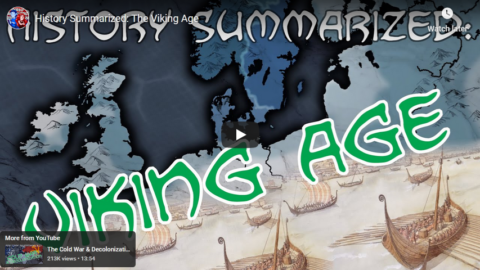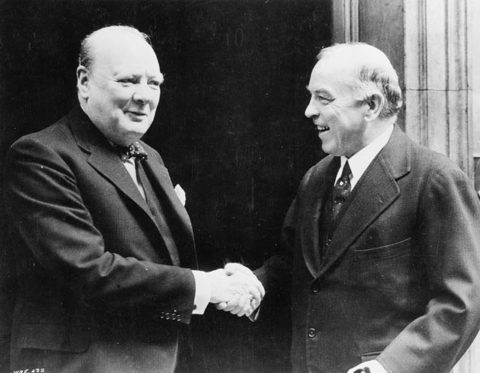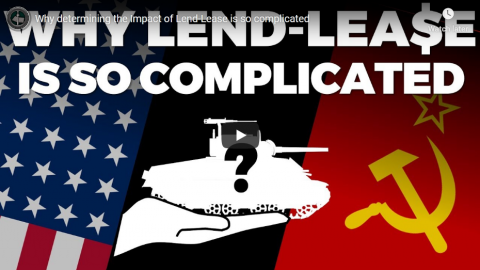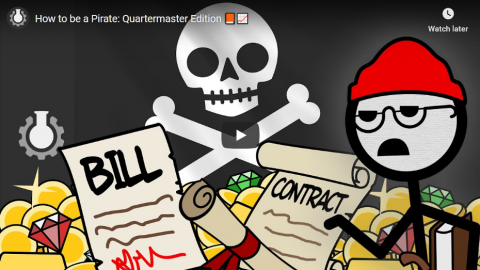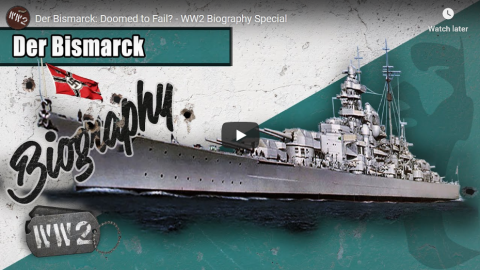The easiest tonnage to understand is displacement tonnage. This is the actual weight of the ship, called displacement because the weight of the ship is equal to the amount of water it displaces, per Archimedes’ principle. Of course, the displacement of a ship can change greatly depending on what’s aboard, so several different displacements are often used. A good reference will give three values, light, normal, and full. Light is basically an empty ship. There are some technical details, but in essence it’s what the ship weighs if we take all the people, fuel, cargo, ammunition, and supplies out of it. Full displacement is exactly what you’d expect from the name. The ship is as heavy as it’s ever going to be, with full fuel, ammo, and cargo. Normal is essentially a ship with full cargo and crew, but two-thirds fuel and ammunition. On warships, it’s common for light displacement to be 75% or so of full displacement, so it’s obvious that a poor choice of reference numbers can cause confusion about the actual sizes of the ships in question. Displacement tonnage in non-metric references is always given in long tons of 2,240 lb each. This is to allow easy conversion, as a long ton of salt water has a volume of almost exactly 35 cubic feet.
Displacement tonnage is the only tonnage value commonly used for warships, while merchant ships use a completely different set of tonnages, usually deadweight tons, gross tons, and net tons. Deadweight tonnage is at least an actual measure of weight, and specifies how much cargo the ship is able to carry, excluding the weight of the ship itself. Gross tonnage and net tonnage are both basically volumetric measures, specified using complicated formulas. Gross tonnage is based on the total volume of all enclosed spaces of the ship, while net tonnage is based only on the volume of the spaces that carry cargo or passengers. These values are used to calculate things like port duties and what regulations apply to the ship. They replaced gross and net register tons, which were also volumetric, of 100 cubic feet to the ton. These were based on a phenomenally complicated set of rules to determine what spaces were and weren’t counted, with shipowners trying to game the system and drive down their tonnage. Worse, different countries had different regulations on what counted under each value, so in 1969, register tonnages were abolished and replaced with the existing system.
While distance, speed, and “tonnage” measurements are the most prominent nautical idiosyncracies, there are a few other values that bear mentioning. The maximum width of a ship is the beam, apparently from the beams that used to run across ships during the days of sail. Draft (or draught) is how deep the hull is below the waterline. This is a very important number to make sure the ship doesn’t run aground, but it varies continually with the amount of stuff on the ship. Air draft is sometimes used for height above the water, important for clearing bridges and the like. Length, much like tonnage, comes in several values. The obvious one is length over all, LOA, which is exactly what it sounds like, measured from the furthest forward to the furthest aft point on the ship. This is obviously useful, but for hydrodynamic purposes another value, waterline length (LWL), is what the designer cares about. The last value is length between perpendiculars (LBP), measured between the vertical stem (bow) post and the vertical stern post. This is another value that was developed for civilian use. Some ships of a given LOA have a great deal of overhang at bow and stern, making them much smaller than other ships with the same nominal LOA. Using LWL is not a good solution, as it varies with draft. LBP solves both of these problems, but isn’t of great importance to warships.
Bean, “Nautical Measurements”, Naval Gazing, 2018-08-10.
November 25, 2020
QotD: Tonnage measurement(s)
October 14, 2020
Wolfpack Killers – U-Boat Tactics – WW2 Special
World War Two
Published 13 Oct 2020German U-Boats were a big threat to Allied shipping across the Atlantic. New inventions and tactics triggered a race to outsmart the opponent, dramatically changing the tides of the Battle of the Atlantic every few months.
Join us on Patreon: https://www.patreon.com/TimeGhostHistory
Or join The TimeGhost Army directly at: https://timeghost.tvFollow WW2 day by day on Instagram @ww2_day_by_day – https://www.instagram.com/ww2_day_by_day
Between 2 Wars: https://www.youtube.com/playlist?list…
Source list: http://bit.ly/WW2sourcesHosted by: Indy Neidell
Written by: Joram Appel
Director: Astrid Deinhard
Producers: Astrid Deinhard and Spartacus Olsson
Executive Producers: Astrid Deinhard, Indy Neidell, Spartacus Olsson, Bodo Rittenauer
Creative Producer: Maria Kyhle
Post-Production Director: Wieke Kapteijns
Research by: Joram Appel
Edited by: Miki Cackowski
Sound design: Marek Kamiński
Map animations: Eastory (https://www.youtube.com/c/eastory)Colorizations by:
https://www.instagram.com/dememorabilia/
Julius Jääskeläinen – https://www.facebook.com/JJcolorization/Sources:
Pugsley, William H./Library and Archives Canada/PA-139273
Bundesarchiv
Narodowe Archiwum Cyfrowe
IWM CH 15219, A 31092, FL 3259
Bletchley Park Trust
from the Noun Project: Cargo Ship by Locad, explosion by Nico TzogalisSoundtrack from the Epidemic Sound:
Johannes Bornlof – “The Inspector 4”
Reynard Seidel – “Deflection”
Johannes Bornlof – “Deviation In Time”
Hakan Eriksson – “Epic Adventure Theme 3”
Johannes Bornlof – “Death And Glory 3”
Phoenix Tail – “At the Front”Archive by Screenocean/Reuters https://www.screenocean.com.
A TimeGhost chronological documentary produced by OnLion Entertainment GmbH.
From the comments:
World War Two
1 day ago
The episode covers some of Otto Kretschmer’s 11 Points of Submarine Warfare. Here’s the full list:1. Efficient lookouts are of prime importance.
2. It is essential not simply to spot the target, but to spot it in good time.
3. Lone ships should be attacked on the surface with gunfire in order to save expensive torpedoes.
4. Survivors should be assisted where possible.
5. Convoys should only be attacked in daylight if it is not feasible to wait for nightfall.
6. Attack at night from the dark side of the convoy, so that the target is silhouetted and the submarine is in shadow.
7. When there is little or no moonlight, attack from the windward side [to avoid a visible white bow-wave when motoring into the wind].
8. Fire one torpedo per target, not fanned salvoes.
9. Fire at close range.
10. Once the attack is launched, do not submerge except in circumstances of dire necessity. Remember that on the surface it is easier for you to spot the enemy than for the enemy to spot you.
11. Dive only for two hours before dawn each day, to rest the crew, sweep with the sound detection equipment, etc.; otherwise, remain on the surface.
September 11, 2020
JS Izumo, Japan’s largest warship
AMANO Jun-ichi
Published 12 Jun 2016https://en.wikipedia.org/wiki/JS_Izumo
At open-house of the Japan Maritime Self-Defense Force Yokosuka Naval Base.
On June 11, 2016.#JMSDF #MSDF
From the Wikipedia entry:
JS Izumo (DDH-183) is a helicopter carrier with a planned future conversion into an aircraft carrier. Officially classified as a multi-purpose operation destroyer, she is the lead ship in the Izumo class of the Japan Maritime Self-Defense Force (JMSDF). She is the second warship to be named for Izumo Province, with the previous ship being the armoured cruiser Izumo (1898).
The ruling Liberal Democrat Party announced in May 2018 that it favours converting Izumo to operate fixed-wing aircraft. The conversion was confirmed in December 2018 when Japan announced the change of its defense guidelines. Upon the completion of the process, Izumo will be the first Japanese aircraft carrier since World War II.
September 5, 2020
History Summarized: The Viking Age
Overly Sarcastic Productions
Published 4 Sep 2020The Vikings are enjoying a new wave of enthusiasm in popular culture, but these seafaring Norsemen are still quite clearly a misunderstood force in medieval European history. So let’s take a wide look at the European world during The Viking Age!
Check out Yellow’s livestreams over at https://Twitch.tv/LudoHistory
SOURCES & Further Reading: The Vikings by Walaker Nordeide and Edwards, Vikings: A Very Short Introduction by Richards, Age of the Vikings and The Conversion of Scandinavia by Winroth, The Vikings By Harl via The Great Courses, The Viking World by Graham-Campbell, The Viking Way by Price.
This video was edited by Sophia Ricciardi AKA “Indigo”. https://www.sophiakricci.com/
Our content is intended for teenage audiences and up.
DISCORD: https://discord.gg/kguuvvq
PATREON: https://www.Patreon.com/OSP
MERCH LINKS: https://www.redbubble.com/people/OSPY…
OUR WEBSITE: https://www.OverlySarcasticProductions.com
Find us on Twitter https://www.Twitter.com/OSPYouTube
Find us on Reddit https://www.Reddit.com/r/OSP/
From the comments:
Ludohistory
23 hours ago (edited)
Thanks so much for having me on and letting me help out! It was a lot of fun (even if I talked a little too fast sometimes)! To clarify a piece that I know I did cover too briefly — missionary trips to Scandinavia occurred in Denmark around 823, on the orders of Louis the Pious, and in Sweden in 829, when Ansgar, a Frankish monk, traveled to the town of Birka, where he found a very small Christian community, probably mostly enslaved or formerly enslaved people, and converted a couple of Norse people, including the town prefect. (The graveyard for that town, incidentally, is where the 10th century “female warrior” that made waves a few years ago was buried).There’s a lot we didn’t get a chance to talk about about the diaspora and its ending, so if there’s anything you all are curious on or find unclear, let me know here or on twitter 🙂
Finally, if you liked this, all the VODs for my personal streams (where I try to ramble about history in games) can be found by clicking on my name, and tomorrow I’ll be streaming CKIII on twitch (link in the description)!
August 9, 2020
MGB 81, the Spitfire of the Seas | World War II gunboat review | Motor Boat & Yachting
Motor Boat & Yachting
Published 16 Jan 2019We have the immense privilege of getting behind the wheel (and guns) of MGB 81, the Spitfire of the seas.
Filmed by Paul Wyeth: http://www.pwpictures.com/
► For the latest reviews, new gear launches and tour news, visit our website here – http://www.mby.com
►Follow us on Twitter here – https://twitter.com/mbytimeinc
July 24, 2020
Winston Churchill and the 1943 Bengal famine
Christopher Howarth on a recent BBC production that threw facts out the window in a rush to condemn British Prime Minister Winston Churchill for the famine in Bengal during 1943:
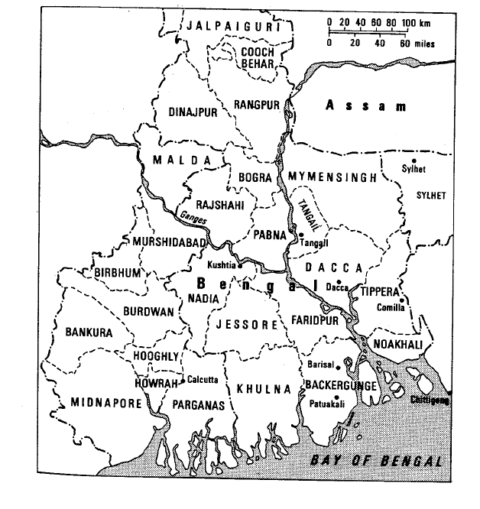
A 1945 map of Bengali districts as of 1943.
Famine Inquiry Commission (1945): Report on Bengal via Wikimedia Commons.
This argument was put forward by the BBC’s own Yogita Limaye, an Indian engineer and reporter on Women’s safety, based on the book Inglorious Empire by Shashi Tharoor, who was interviewed to give his opinion that Churchill was an “odious figure of reprehensible views and racist attitudes.”
No doubt the narrative of British evil and oppression is believed in India and elsewhere, but that does not make it true or worthy of the BBC reporting it as fact without any semblance of balance. The BBC failed its licence fee paying audience in two main regards, namely, conceptually and factually.
The British ruled India, one of the largest populations on earth, for well over two centuries. Good and bad things happened, just like everywhere else ever. You can join the dots to create whatever picture you like – Dr Tharoor chose the picture he wished to create. Why is the Bengal famine uniquely interesting to a BBC audience in 2020 over say a mini-series on British Railways and development in India? BBC presenters are demonstrably more interested in the first narrative: this is a major conceptual failing on their part. Being equal mixtures primitivism and solipsism. Always the borderline racist Western assumption is that “we” did things to “them”: we had agency, they were passive brutes. They are boring, we are endlessly interesting. Let’s talk about us. However even the slightest knowledge of the British-in-India teaches one that “we” did nothing without them. How on earth could we? There were famously few of us.
Yet it’s the second great BBC failing – over accuracy – which is so especially galling. On the actual allegation the BBC is plain wrong. Churchill was not responsible for the Bengal famine as any actual delving into the facts would have shown. Note well that they didn’t even try.
In 1943 Britain was at war with Japan, who were at the gates of India having occupied Burma, a major supplier of grain to Bengal. Important facts. Bengal was in the grips of a famine, nobody disputes that. But Churchill was not responsible, neither for the weather nor the agriculture nor the Japanese aggression.
Even the BBC did not allege that Churchill instigated the famine, the charge sheet is that he refused to help when he could. There were “stockpiles [of food] in the UK” and shipping which was retained in the northern hemisphere, prioritised for use there. Stockpiles of food in the UK in 1943? Even if there was the food and shipping, transporting US corned beef to Bengal would have been ludicrous. If there was shipping and protection from Japanese naval assault the food would have come from the rest of India. So why was food not transported from other parts of India to Bengal?
July 21, 2020
The Destruction of Convoy PQ17: Merchant Ships Left Defenceless
Historigraph
Published 18 Jul 2020For unlimited access to the world’s top documentaries and nonfiction series go to http://go.thoughtleaders.io/166892020… and use the promo code ‘
historigraph‘ to get 30 days free access.Buy Historigraph Posters here! teespring.com/stores/historigraph
Support the channel on Patreon: https://www.patreon.com/historigraph#ConvoyPQ17 #Historigraph #CuriosityStream
► Twitch: https://www.twitch.tv/addaway
► Twitter: https://twitter.com/historigraph
► Instagram: https://www.instagram.com/historigraphMusic:
“Rynos Theme” Kevin MacLeod (incompetech.com)
Licensed under Creative Commons: By Attribution 4.0 License
http://creativecommons.org/licenses/b…The Descent by Kevin MacLeod
Link: https://incompetech.filmmusic.io/song…
License: http://creativecommons.org/licenses/b…Crypto by Kevin MacLeod
Link: https://incompetech.filmmusic.io/song…
License: http://creativecommons.org/licenses/b…
July 14, 2020
A previously unpublished photo of the 1917 Halifax explosion
I’ve posted a few items about the Halifax explosion, so Colby Cosh linking to this CBC News article caught my attention:
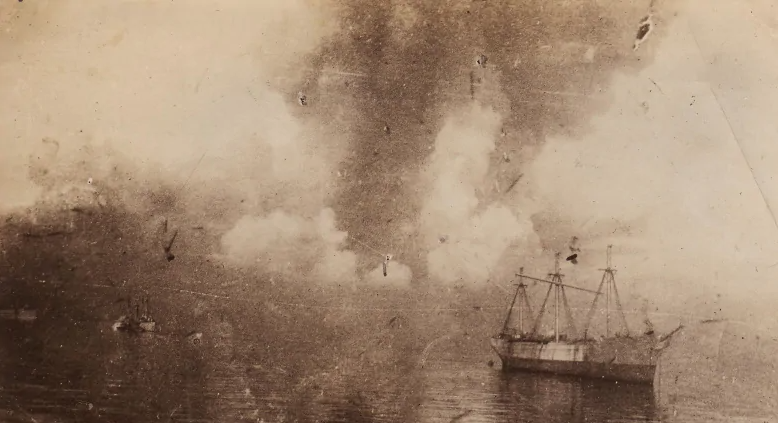
Previously unpublished photo of the Halifax explosion in December 1917 taken by Mate Reg Stevens, RCN.
Original image from the Community Archives of Belleville and Hastings County, via CBC News.
“The photo has the look of a very troubling dream,” Dan Conlin says as he studies an old black-and-white image.
Conlin is a transportation historian who’s spent a lifetime studying images of ships, trains and aircraft. He’s also a former curator of Halifax’s Maritime Museum of the Atlantic, which houses a large collection of materials from the 1917 Halifax Explosion.
The image he’s studying surfaced recently on Reddit with a user from Halifax, England, wondering if it was a “new” image of the 1917 disaster.
“You have these tranquil little wavelets in the foreground and some stately, anchored vessels — including a sailing ship,” Conlin said. “But in the background there are these awful, nightmarish clouds, including a horrible column that is rising into the sky. It looks like a surreal nightmare.”
When Conlin first looked at it, the crisp details of the foreground and the blurry background raised his skeptical eyebrows. “There was quite a tradition in the World War I era of faking photos by doing composite photos, where you layer one image on top of another,” he said.
One well-known photo of the explosion taken from McNabs Island was later suspected to have been doctored by a company. They seem to have added clouds for dramatic effect — and to sell more postcards.
But Conlin thinks in the nightmarish photo, it’s more likely that the clouds are moving from the force of the explosion, while the ships were untroubled by any winds. The disaster killed nearly 2,000 people and badly hurt thousands more. It levelled the Richmond district in the north end.
“It’s carnage and destruction out of Dante at the base of that cloud. People are dying and fires are starting and this awful event has hit Halifax in the distance,” he said.
“That angry cloud gives you an idea of the violence and tragedy that is unfolding even as the shutter clicks. It’s really rare and that photo, as far as I can tell, has never been published.”
June 9, 2020
Hiding your Army | Military Camouflage | The Tank Museum
The Tank Museum
Published 10 May 2020Curator David Willey talks to you about military camouflage, from home! He takes a look at military uniform and vehicles.
Support the work of The Tank Museum on Patreon: ► https://www.patreon.com/tankmuseum
Visit The Tank Museum SHOP & become a Friend: ► https://tankmuseumshop.org/Twitter: ► https://twitter.com/TankMuseum
Instagram: ► https://www.instagram.com/tankmuseum/
Tiger Tank Blog: ► http://blog.tiger-tank.com/
Tank 100 First World War Centenary Blog: ► http://tank100.com/
June 7, 2020
Why determining the Impact of Lend-Lease is so complicated
Military History Visualized
Published 14 Aug 2018Determining the impact of the Western Aid that was provided to the Soviet Union in the Second World War is quite controversial. This aid was provided under the Lend-Lease act, as such it is usually just called Lend-Lease. The majority of the support was provided by the United States, yet other countries like the United Kingdom and Canada aided the Soviet Union as well.
Thank you to VonKickass for the Thumbnail Design!
»» SUPPORT MHV ««
» patreon – https://www.patreon.com/join/mhv
» paypal donation – https://www.paypal.com/cgi-bin/webscr…»» MERCHANDISE – SPOILS OF WAR ««
» shop – https://www.redbubble.com/people/mhvi…»» SOCIAL MEDIA ««
» twitter – https://twitter.com/MilHiVisualized
» twitch – https://www.twitch.tv/militaryhistory…» SOURCES «
Boris V. Sokolov: “The role of lend‐lease in Soviet military efforts, 1941–1945”, The Journal of Slavic Military Studies, 7:3 (1994) p. 567-586
Hill, Alexander: The Red Army and the Second World War. Armies of the Second World War. Cambridge University Press: Cambridge, UK, 2017.
Glantz, David M.; House, Jonathan M.: When Titans Clashed. How the Red Army stopped Hitler. Revised and Expanded Edition. University Press of Kansas: USA, 2015
Harrison, Mark: THE SOVIET ECONOMY AND RELATIONS WITH THE UNITED STATES AND BRITAIN, 1941-1945, Draft 25 August, 1993
Hill, Alexander: “British Lend Lease Aid and the Soviet War Effort, June 1941 June 1942”, in: The Journal of Military History, Vol. 71, No. 3 (Jul., 2007), pp. 773-808
Cambridge History of the Second World War. Volume 1: Fighting the War. Cambridge University Press: UK (2015)
Broadberry, Stephen; Howlett, Peter: “The United Kingdom: ‘Victory at all costs'”, in: Harrison, Mark (ed.): The Economics of World War II. Cambridge University Press: UK (1998), p. 43-80
Strydwolf: Lend-Lease to Soviet Union, significance, impact and myths
Protocol and Area Information Staff of the U.S.S.R. Branch and the Division of Research and Reports: REPORT ON WAR AID FURNISHED BY THE UNITED STATES TO THE U.S.S.R, November 28, 1945
Harrison, Mark: “The USSR and Total War: Why Didn’t the Soviet Economy Collapse in 1942?” In: Chickering, Roger (ed.); Förster, Stig (ed.); Greiner, Bernd (ed.): A World at Total War: Global Conflict and the Politics of Destruction, 1939-1945, Cambridge: Cambridge University Press (2005), p. 137-156.
Tooze, Adam: The Wages of Destruction. The Making and Breaking of the Nazi Economy. Penguin Books: United Kingdom (2006).
Overy, Richard: Why the Allies Won. Pimlico: London, UK (2006).
Higham, Robin (ed.); Kagan, Frederick W. (ed.): The Military History of the Soviet Union. Palgrave: New York, 2002
Havlat, Denis: Western aid for the Soviet Union during World War II, Wien, 2015 (Master Thesis)
» DATA CHAIN «
Made with Natural Earth. Free vector and raster map data @ naturalearthdata.com.» CREDITS & SPECIAL THX «
Song: Ethan Meixsell – “Demilitarized Zone”
June 3, 2020
How to be a Pirate: Quartermaster Edition 📙📈
CGP Grey
Published 2 Jun 2020‣ Adapted largely from The Invisible Hook. It’s great, go read it: https://amzn.to/36PLKSE
‣ Director’s Commentary later today: https://www.patreon.com/cgpgrey## Special Thanks
Peter T. Leeson for reviewing a draft of the script. Check out his newest book, WTF?!: An Economic Tour of the Weird: https://amzn.to/3eEMm09
## Crowdfunders
Steven Snow, Bob Kunz, John Buchan, Nevin Spoljaric, Donal Botkin, BN-12, Chris Chapin, Richard Jenkins, Phil Gardner, Martin, سليمان العقل, Steven Grimm, Colin Millions, Saki Comandao, Jason Lewandowski, Andrea Di Biagio, David F Watson, Ben Schwab, Elliot Lepley, rictic, Bobby, Marco Arment, Shallon Brown, Shantanu Raj, emptymachine, George Lin, Henry Ng, Jeffrey Podis, Thunda Plum, Awoo, David Tyler, Derek Bonner, Derek Jackson, Fuesu, iulus, Jordan Earls, Joshua Jamison, Mikko, Nick Fish, Nick Gibson, Orbit_Junkie, Ron Bowes, Tómas Árni Jónasson, Tyler Bryant, Zach Whittle, Oliver Steele, Kermit Norlund, Kevin Costello, Ben Delo, Arctic May, Bear, chrysilis, David Palomares, Emil, Erik Parasiuk, Esteban Santana Santana, Freddi Hørlyck, Frederick The Great, John Rogers, ken mcfarlane, Leon, Maarten van der Blij, Peter Lomax, Rhys Parry, ShiroiYami, Tijmen van Dien, Tristan Watts-Willis, Veronica Peshterianu, Dag Viggo Lokøen, John Lee, Maxime Zielony, Bryan McLemore, Elizabeth Keathley, Alex Simonides, Felix Weis, Melvin Sowah, Giulio Bontadini, Paul Alom, Ryan Tripicchio, Scot Melville
## Music
David Rees: http://www.davidreesmusic.com
June 1, 2020
How to be a Pirate 🏴☠️
CGP Grey
Published 30 May 2020‣ Adapted largely from The Invisible Hook. It’s great, go read it: https://amzn.to/36PLKSE
‣ Thank you, my Patrons, for making this video possible: https://www.patreon.com/posts/37699725## Special Thanks
Peter T. Leeson for reviewing a draft of the script. Check out his newest book, WTF?!: An Economic Tour of the Weird: https://amzn.to/3eEMm09
## Crowdfunders
Steven Snow, Bob Kunz, John Buchan, Nevin Spoljaric, Donal Botkin, BN-12, Chris Chapin, Richard Jenkins, Phil Gardner, Martin, سليمان العقل, Steven Grimm, Colin Millions, Saki Comandao, Jason Lewandowski, Andrea Di Biagio, David F Watson, Ben Schwab, Elliot Lepley, rictic, Bobby, Marco Arment, Shallon Brown, Shantanu Raj, emptymachine, George Lin, Henry Ng, Jeffrey Podis, Thunda Plum, Awoo, David Tyler, Derek Bonner, Derek Jackson, Fuesu, iulus, Jordan Earls, Joshua Jamison, Mikko, Nick Fish, Nick Gibson, Orbit_Junkie, Ron Bowes, Tómas Árni Jónasson, Tyler Bryant, Zach Whittle, Oliver Steele, Kermit Norlund, Kevin Costello, Ben Delo, Arctic May, Bear, chrysilis, David Palomares, Emil, Erik Parasiuk, Esteban Santana Santana, Freddi Hørlyck, Frederick The Great, John Rogers, ken mcfarlane, Leon, Maarten van der Blij, Peter Lomax, Rhys Parry, ShiroiYami, Tijmen van Dien, Tristan Watts-Willis, Veronica Peshterianu, Dag Viggo Lokøen, John Lee, Maxime Zielony, Bryan McLemore, Elizabeth Keathley, Alex Simonides, Felix Weis, Melvin Sowah, Giulio Bontadini, Paul Alom, Ryan Tripicchio, Scot Melville
## Music
David Rees: http://www.davidreesmusic.com
May 29, 2020
Der Bismarck: Doomed to Fail? – WW2 Biography Special
World War Two
Published 28 May 2020The Bismarck is without a doubt a force to be reckoned with. But with the Kriegsmarine experiencing an identity crisis throughout the 1930s, the Bismarck‘s design and strategic purpose foreshadow a dramatic ending.
Join us on Patreon: https://www.patreon.com/TimeGhostHistory
Or join The TimeGhost Army directly at: https://timeghost.tv
Check out our TimeGhost History YouTube Channel: https://www.youtube.com/c/timeghost?s…Follow WW2 day by day on Instagram @World_war_two_realtime https://www.instagram.com/world_war_t…
Between 2 Wars: https://www.youtube.com/playlist?list…
Source list: http://bit.ly/WW2sourcesHosted by: Indy Neidell
Written by: Joram Appel
Director: Astrid Deinhard
Producers: Astrid Deinhard and Spartacus Olsson
Executive Producers: Astrid Deinhard, Indy Neidell, Spartacus Olsson, Bodo Rittenauer
Creative Producer: Joram Appel
Post-Production Director: Wieke Kapteijns
Research by: Joram Appel
Edited by: Mikołaj Cackowski
Sound design: Marek Kamiński
Map animations: Eastory (https://www.youtube.com/c/eastory)Colorizations by:
Ruffneck88, Wikimedia Commons
Norman Stewart – https://oldtimesincolor.blogspot.com/Sources:
Bundesarchiv
IWM HU 374, HU 67486, HU 1041, HU 108392, A 6155, D 2373, HU 55631
From the Noun Project: Game by Ecem Afacan, Shield by Nikita KozinSoundtracks from the Epidemic Sound:
Phoenix Tail – “At the Front”
Johannes Bornlof – “The Inspector 4”
Rannar Sillard – “March Of The Brave 10”
Max Anson – “Ancient Saga”
Johannes Bornlof – “Deviation In Time”
Reynard Seidel – “Deflection”Archive by Screenocean/Reuters https://www.screenocean.com.
A TimeGhost chronological documentary produced by OnLion Entertainment GmbH.
May 8, 2020
QotD: Measuring beauty
Helen of Troy was renowned as a very beautiful woman, said to have possessed “the face that launched a thousand ships” (i.e. to invade Troy and rescue her). Her name has thus become a unit of measure of beauty. For example, a millihelen has been defined as “the amount of beauty needed to launch a single ship”, whereas a negative helen is “the amount of negative beauty (i.e. ugliness) that can beach a thousand ships”.
Peter Grant, “How do you measure up?”, Mad Genius Club, 2018-01-28.
May 7, 2020
Interesting change in shipping patterns … to avoid the Suez canal
Colby Cosh linked to this story at gcaptain.com which would have been an unbelievable one in the pre-epidemic world:
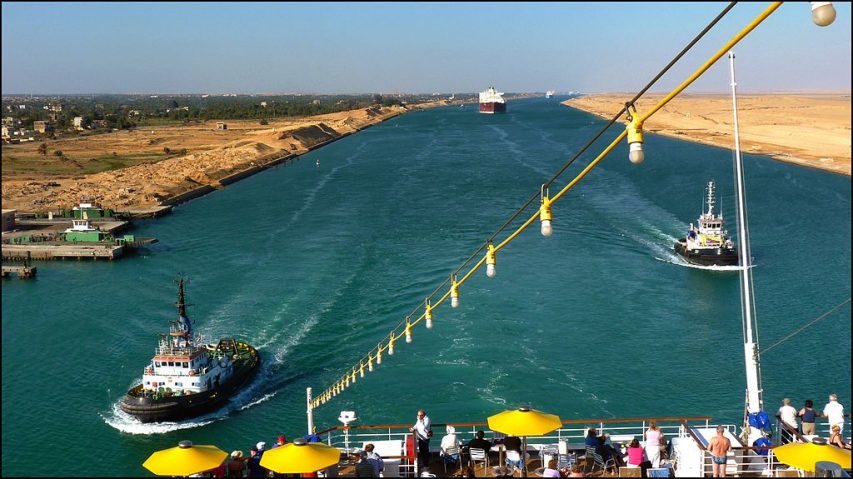
A column of ships along the Suez Canal on 3 December, 2011.
Photo by https://web.archive.org/web/20161022104657/http://www.panoramio.com/user/2433337?with_photo_id=64163879 via Wikimedia Commons.
The Suez Canal Authority (SCA) is set to lose over $10m in revenue from container lines routing vessels via the Cape of Good Hope rather than its waterway.
According to new Alphaliner research, “the number of containerships that have opted to use the Cape route and bypass the Suez Canal has risen to a historic peace-time high,” including at least 20 sailings on the Asia-Europe, Europe-Asia and North America east coast-Asia trades.
“A unique combination of a container tonnage surplus and rock-bottom bunker prices has increasingly prompted ocean carriers to avoid the canal – and thus its fees,” the analyst noted today.
“Rather unusually, even three westbound Asia-Europe headhaul sailings have opted for the Cape route, all operated by CMA CGM.
“Carriers very rarely choose this longer route for the time-sensitive headhaul, but the low bunker price and lack of demand in European markets, hit by the Covid-19 lockdowns, have suddenly made such moves viable,” it added.



